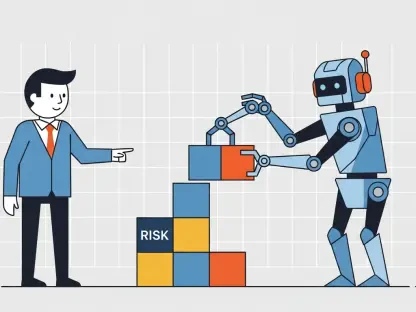Self-checkout (SCO) systems have become a staple in modern retail due to the demand for speed and convenience. However, the rise of SCO has also brought significant security challenges, particularly concerning fraud and theft. Traditional security measures are failing to keep up with these new threats, necessitating the adoption of advanced solutions driven by artificial intelligence (AI) and automation.
The Rise of Self-Checkout and Its Challenges
Self-checkout systems have fundamentally transformed the retail landscape, providing a quick and user-friendly avenue for customers to complete their purchases. Initiated primarily to streamline operations and cut costs amidst growing consumer preference for fast shopping experiences, SCO has become increasingly popular. However, this widespread adoption inadvertently opened doors to sophisticated fraud tactics that exploit inherent security weaknesses. While customers appreciate the convenience, retailers grapple with the dual challenge of maintaining efficiency and ensuring robust security.
Convenience vs. Security
Balancing the need for convenience without compromising security presents a significant dilemma for retailers. SCO systems were designed to meet the modern consumer’s need for speed and convenience, yet these systems have become soft targets for fraudsters. Shoppers enjoy the efficiency, but the opportunities for fraud are manifold. Issues such as barcode switching, non-scans, and manipulation of item counts are increasingly common. Combating these tactics requires innovative strategies capable of adapting to evolving fraud methods, as traditional security measures like manual audits and random checks are swiftly becoming obsolete.
Traditional Security Inefficiencies
Retailers have long relied on a triad of security measures: manual audits, random checks, and video surveillance to mitigate losses associated with SCO. However, these methods are proving inadequate as fraud tactics become more sophisticated. Manual audits can miss nuanced manipulations, random checks are too sporadic to be fully effective, and video surveillance often acts as a reactive measure rather than a proactive deterrent. The surge in barcode switching incidents, non-scans, and organized retail crime (ORC) highlights the pressing need for a significant overhaul in security strategy.
The Advent of AI-Driven Solutions
The retail industry is witnessing a transformative shift with the integration of AI-driven loss prevention solutions. These advanced technologies address the limitations of traditional security measures, delivering more accurate and efficient fraud detection capabilities. In a landscape characterized by increasingly sophisticated fraud tactics, AI provides the advanced tools necessary for proactive security. Retailers are transitioning to these solutions to gain the upper hand in the relentless battle against theft and shrinkage, leveraging AI’s potential to redefine the efficacy of SCO security.
AI Integration in Retail
Artificial intelligence has become an essential ally for retailers looking to combat fraud more effectively. The industry’s plans to embrace AI-driven solutions within the year reflect this trend. Technologies such as computer vision, machine learning models, and edge-based security are being deployed to create more robust loss prevention systems. These systems do not merely detect anomalies but can predict fraudulent activities, thereby enabling real-time intervention. AI essentially shifts the paradigm from a reactive to a proactive approach, which is crucial given the dynamic nature of retail fraud.
Real-Time Fraud Detection
AI’s ability to provide real-time monitoring of self-checkout lanes marks a significant leap forward in fraud detection. Through computer vision and real-time analytics, AI can identify and flag suspicious activities such as barcode switching, item misplacement, and non-scanned products without human intervention. Edge AI technology processes data at the device level, ensuring immediate response and minimizing latency associated with cloud-based systems. This ability to detect and react to fraudulent behavior instantaneously greatly enhances the security and reliability of SCO environments.
Enhancing Security with AI and Automation
The integration of AI and automation in self-checkout security systems offers a multi-faceted approach to combating retail fraud. The combination of edge AI, advanced sensors, and real-time analytics forms a comprehensive security framework that extends beyond traditional methods. Retailers are increasingly recognizing the value of embedding these technologies within their checkout processes to enhance fraud detection and streamline operations. The advanced capabilities of AI-powered systems are pivotal in creating a more secure and efficient retail environment.
Edge AI and Device-Level Security
Edge AI processing allows for instant fraud detection directly at the checkout device. This capability reduces the dependency on cloud-based systems, which can experience latency and other delays. Immediate response to fraudulent activities is crucial, as it prevents loss as it happens and maintains the integrity of SCO systems. Moreover, by processing data locally, edge AI enhances security by ensuring sensitive information is not transmitted over potentially vulnerable networks. The incorporation of edge AI technology into SCO devices represents a significant advancement in retail fraud prevention.
Smart Sensors and Verification
Smart weight sensors add an additional layer of security to self-checkout systems. These sensors verify that the weight of scanned items matches the expected weight, effectively preventing common types of mis-scanning fraud. By cross-referencing products against their expected characteristics, these smart sensors identify discrepancies that manual checks might overlook. The result is a more accurate and secure transaction process. Integrating these sensors into SCO systems not only enhances accuracy but also provides customers with a smoother and more trustworthy checkout experience.
Balancing Security and Customer Experience
Implementing advanced security measures in SCO systems necessitates a careful balance to ensure that the customer experience remains positive. Retailers face the challenge of introducing rigorous security protocols without causing inconvenience to honest shoppers. AI offers a solution by enabling a tiered security approach, which adjusts interventions based on the transaction’s risk level. This strategy ensures that security mechanisms are stringent enough to prevent fraud but flexible enough to maintain a seamless shopping experience for customers.
Seamless Customer-Friendly Security
Retailers must strategically implement security measures that safeguard against fraud while ensuring a smooth and pleasant shopping experience. AI facilitates a tiered security approach, dynamically adjusting the level of intervention based on each transaction’s perceived risk. For low-risk transactions, AI enables a seamless checkout with minimal interruptions, preserving the convenience and speed that consumers expect from SCO systems. Medium-risk transactions may prompt subtle verifications, while high-risk transactions can trigger immediate interventions. This adaptability ensures that security measures are both effective and discreet.
Collaboration Between AI and Store Associates
Contrary to the notion that AI replaces human workers, AI in retail augments the role of store associates by enhancing their decision-making capabilities. AI systems filter out false positives, providing associates with real-time insights and focusing their attention on genuine threats. This synergy between AI and human workers results in more efficient and effective security interventions. Store associates equipped with AI-driven insights can make informed decisions quickly, ensuring that security measures are both necessary and customer-friendly. This collaborative approach enhances overall store security without compromising service quality.
Comprehensive AI-Powered Strategies
The ultimate goal for retailers is to develop comprehensive AI-powered loss prevention strategies that go beyond isolated monitoring of self-checkout lanes. The integration of sophisticated AI technologies into a larger IoT-driven security ecosystem provides a holistic approach to combating retail fraud. This multi-layered strategy ensures that all aspects of the retail environment, from the point of entry to the checkout, benefit from enhanced security measures. By leveraging the full spectrum of AI capabilities, retailers can create a more secure and efficient shopping experience.
Beyond Isolated Monitoring
Future self-checkout security entails deploying AI-powered loss prevention tactics extending beyond limited SCO monitoring. This expanded approach integrates various advanced technologies, creating an IoT-driven security ecosystem capable of tracking high-value items and promptly identifying anomalies. Far-edge AI facilitates real-time detection, while near-edge AI focuses on sophisticated behavioral analysis. Together, these technologies enhance overall security, seamlessly integrating into the retail environment to safeguard against fraud without disrupting the customer experience.
Multi-Level AI Deployment
Self-checkout (SCO) systems have become increasingly prevalent in modern retail environments, driven by consumer demand for speed and convenience. However, the rise of these systems has also introduced significant security challenges, especially related to fraud and theft. Traditional security measures are struggling to keep pace with these evolving threats, creating a need for more sophisticated solutions. As a result, retailers are turning to advanced technologies like artificial intelligence (AI) and automation to enhance the security of SCO systems. These innovations are not only improving the accuracy and efficiency of fraud detection but also helping retailers stay ahead of potential risks. By leveraging AI and automation, businesses aim to safeguard their operations while continuing to offer the fast, seamless checkout experience that customers expect. Consequently, the integration of these futuristic technologies is becoming essential in the ongoing effort to ensure secure and efficient self-checkout processes in the retail industry.









